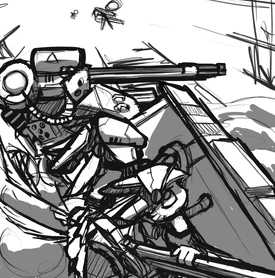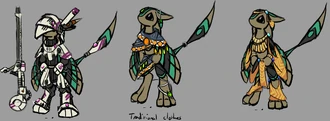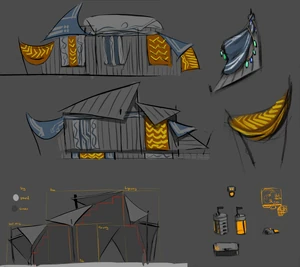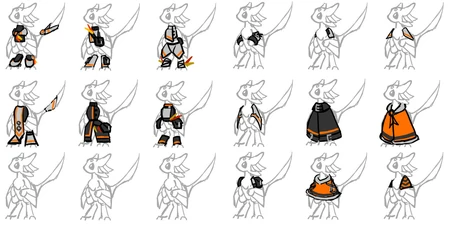Like their independent kin, the avali tribes pride themselves on having their own individual customs, life and architectural styles as much as is compatible with the needs of the central government. A trait readily maintained thanks to the relative seclusion of independent colonies and the societal need for integration of newcomers.
However, as a species, there are still certain cultural norms most tribes display. It should be stressed, that while tribes are an important concept culturally, the vast majority of avali are not necessarily in a tribe at any given time. As a post-scarcity, post-labor economy the population is ensured a minimum standard of living (A standard that many species would consider borderline Utopian).
Packs[]

Evolved from relatively small and flimsy pack hunters, that later formed nomadic tribes, avali society displays a strong tiered hierarchy; at the lowest order, packs of 3-6 individuals, bonded from a young age. While the individual pack members often have a range of skills, the pack tends to become specialized towards certain tasks which becomes their role in a tribe. Pack members are rarely genetically relatives, but nonetheless, those raised together form extremely close bonds; most packs then go on to form their own internal memetic cues which, in tandem with their incredible auditory processing, enables them to process information and exchange ideas extremely quickly. The loss of a long-term pack member is extremely crippling to a group's performance; as is isolation from their pack. Replacement of pack members is possible, but unusual, given that surrogate packs lack the initial bonds and memetics of the previous group, and pack fragments of correct age and temperament to fill the gap are rare.
Tribes[]
Packs in turn form into tribes, large groups of individuals with a shared purpose and containing packs with complementary skill sets towards the tribe's overall goals. Tribes are rarely permanent affairs (though some trace their lineage back generations), and are often pulled together by a colony, local leader or illuminate government.
They are in essence a form of free company, wholly owned and operated by its member packs in accordance with some internal agreement on purpose and resource distribution. One example of a tribe might be asteroid miners coming together to clear out a newly discovered resource-rich asteroid, and the illuminate government creates a work order to obtain a certain volume of resources over a given window, assigns a leader pack with experience and releases an inventory of equipment (mining platforms, drones, mobile refineries), needed to complete the project. The leader then sets out to recruit the appropriate crew; drone specialists, engineers, surveyors, support staff, and so on, in order to complete the project.
In addition to any promised benefits (such as better accommodation rights, references, equipment requisition), any production above and beyond that demanded by the work order also becomes the possession of the tribe, to trade or use as they see fit.
Colonies[]
Often it helps tribe productivity to locate themselves physically near to other existing tribes; for example, a tribe tasked to manufacture electronics would benefit from positioning their facilities close to a tribe extracting rare earth metals, reducing their reliance on long-range transportation. In turn, these tribes may establish more permanent facilities and a support infrastructure builds up around them, becoming a true colony.
These colonies go on to create a colonial council with representatives of the packs as well as one or more representatives of the illuminate government to help in administrating colony affairs.
If a permanent colony is considered strategically important enough, and given official recognition it receives Nexus nodes, long-range FTL communications, residential facilities and supply and distribution networks for temporary and mobile tribes to feed into as well as a representative pack to stand on the administration council.
Design and Construction[]
There is little evidence remaining of ancient avali civilization and design techniques. Early avali were even more nomadic than their modern descendants, and permanent structures were rare. The only evident ancient construction is that of the old mountaintop cities jutting above Avalon’s tundra, but out of necessity enforced by the scarcity of solid ground, many of the oldest of these structures have been disassembled, built over, or replaced with newer structures over the generations to ensure efficient use of the limited space.
Occasionally, however, refurbishments break into long forgotten catacombs or ancient dwellings, which often contain a wealth of information about the past.
Modern avali techniques, however, mix high-technology and nomadic sensibilities in equal measure; portable stoves replace campfires, synthesizers supplant traditional fireside music, and holographic displays are set up where embroidered tapestries might have once been hung in a tent. Carbon nanofibre weave provides tents that can stop bullets, while VTOL dropships and drones carry the tribe and their supplies far more efficiently than animals and sleds, and can provide safety when danger arises.
Nomads to the core, the avali build both their tools and structures to the axiom of “keep it simple, discard what you can afford to, and look after that which you cannot.” avali design places much emphasis on lightweight, space-saving techniques. When possible, their tools are designed to be flash-forged from a 3D printer and discarded after use rather than adding to the weight of travel.

avali armor and clothing concepts.
Standing in stark contrast to this behavior is their treatment of what gear they deem irreplaceable. Armor and weapons are all made from the highest-quality materials and maintained with a great deal of care. Avali gear tends to feature extensive personalization, modification, and customization unique to the owner, making them one of the few truly personal belongings among the otherwise pack and tribe oriented avali.

avali tent design concepts.
The tundra regions of Avalon are comparatively warm to the avali, who are natives of the environment. Other races may see them as crazy bird-folk camping in a frozen wasteland, but the avali do not think that way. They see themselves as desert nomads, using their tents to shelter themselves from the abrasive snow being blown across the ice sheets.
Permanent settlements are not unheard of on Avalon however, despite the prevalent nomadic attitude. Though the glacial shift of the tundra makes building a city in most places a fool’s errand, some mountains jut up through the ice shelf and provide a stable foundation for more permanent dwellings and installations. These mountaintops have become densely-colonized cities with tall, space-efficient tower blocks and high population densities. In spite of this, few of the mountain fortresses have sufficient room to dedicate to non-essential requirements such as habitation, and instead give themselves entirely to housing crucial infrastructures such as reactor complexes, research labs and communications relays. With little room for settlement inside, the mountain cities serve primarily as trading and infrastructure hubs for the nomadic majority of the avali populace living on Avalon.
Arts and Aesthetics[]

A variety of colorful avali clothing designs.
The avali are a highly artistic race. Having achieved, for all intents and purposes, a post-scarcity economy, creativity has become one of the most valuable assets a pack can have. As might be expected given incredible avali auditory processing and comparatively poor vision, musical and performance art tends to be significantly more popular than visual arts. Unsurprisingly, many avali have some degree of musical experience and can either play an instrument or sing. Many packs play together as a band, a tendency that begins at a young age as avali kits often play games based around sound and music.
Though fine visual distinctions are often wasted upon them, the avali still appreciate intricate and high-contrast decorative patterns in their tent work and clothing. Packs usually have a set of colors, a sort of informal heraldry, that they prefer and identify themselves with through their belongings and clothing. Avali dress often integrates crystalline and metallic chimes as the auditory equivalent of wearing bright colors. Though a human ear might find the din distracting, the avali are no more confused by the melodies of a crowd than the human eye is by the task of tracking a single face among dozens.
Though their culture is decentralized in physical terms, the Nexus provides even the most isolated tribes with a social outlet for their talents. Between their lively musical culture and their strongly colored banners and tents, the nomadic colonies of the avali can be quite vibrant places and are popular destinations among alien travelers adventurous enough to brave the hostile environment.
Oracle Cult[]
Despite the name, the oracle cult is far from a "bad" thing. They are a sect of transhumanists (or rather, transavalists) that date back to the inception of the Oracle system. Whereas most avali have some amount of physical augmentation, the oracle cult takes it to a far more extreme degree. Extensive neural augmentation allows them to communicate empathically with other members of the cult and access databases, drones, cameras, and other nanotech devices intuitively, giving them apparent omniscience to everything occurring around them.
As a group, their intention is to reach the stage where they can merge through augmentations with the Oracle system and "ride" the technological singularity. Rather than being left behind by the singularity, they intend to fully comprehend and benefit from the Oracle's knowledge and processing capacity.
The merging of nexus, modern nanotech and the Oracle system would likely make the Oracle cult the technological gods of their own creation. Despite their ultimate goal, they are fully aware of the potential danger posed by a truly free Oracle system, and agree that for now it needs to remain shackled.
Religion and Philosophy[]
Early avali tribes held an animistic belief system that supposed all things, living and inanimate held a "spirit" that defined the essence of that place or concept, and those that lived and died a part of it would become a permanent part of the essence that made a place what it was.
Packs, though made of individuals, represented a singular goal or spirit; likewise for larger unions such as tribes. Particularly old and storied tribes were seen to have strong, noble spirits and so it was an honor for the packs to be a part of, and do their best not to dishonor them.
In some traditions, new packs coming of age would adopt the names of long dead packs that displayed similar qualities and so continue to feed into the spirit it represented.
Serious adherence to religious tradition, even their ancient animist belief system, is relatively low these days. But references to the old ways crop up often in their language, storytelling and traditions, such as pack naming.
Adherence to alien religions is generally discouraged by the illuminate authority due to potentially subversive messages, though outside of the illuminate uptake of alien belief systems among avali are not unknown. However, most find these beliefs to be quite bizarre or even offensive; notions like singular creator gods or individual souls are given a wide berth.